Looking Over the Edge
Dave Wagner
For me, picking out a new telescope is right up there with buying a new car. Expecting to live with your choice for many years, it's well worth some research and it means making some difficult tradeoffs. Will you drive just around town or travel cross country? Manual or automatic? Navigation system? How fast do you need it to go? Will it fit in the garage? Chevy, Ford? What options can I afford? Motorbike, car, or eighteen wheeler? And of course everyone balances these decisions differently.
Some good news for the amateur astronomers, is that when it comes to buying a scope, there are more and more choices available to us. Innovation for amateur astronomers continues, despite the niche market.
Say Goodbye, Goldilocks - Wanting to get more engaged in astrophotography and to take my observing up a level, I found myself in need of a new telescope. My 'old' scope is a fine 8" Nexstar GPS. When I purchased it, it was selected to be my 'Goldilocks' telescope.
Not too big, not too small. Portable, but just barely.
Not too hot, not too cold. Decent planetary, decent deep sky.
Not too hard, not too soft. Software is easy to use and Go To is accurate.
While the 'Goldilocks' telescope provided sustenance over the past few years, my palate was looking for something 'hot', and I was willing to potentially make some trade-offs to get a hotter dish. Unfortunately I do only have a one car garage, so Goldilocks will have to go and this new scope will have to also serve my need for portability and ease of use as my 'only' scope.
Foundation - My first choice was to go to a German Equatorial Mount (Losmandy), to give me full flexibility and capability in the astrophoto arena (perhaps more on this mount in a future article). In terms portability, even though this is a very heavy duty mount, the five mount components (no OTA) are all lighter than the two components in my 8" Nexstar GPS (which includes the OTA). So while I have a few more components than before, they all are as easy to manage as the Nexstar.
OTA Options - Starting with a GEM foundation I now have flexibility to chose from many types and brands of OTA to put on the mount. That said, my familiarity with the astrophoto friendly SCT and my ownership of SCT focusers and adapters put an SCT first on my list. I considered from 8" up to 14" aperture scopes. While the GEM mount would get a lot out of an 8" scope for astrophotography, a larger aperture would take it up a notch for planetary and deep sky observing. Going up to a 14" SCT however was a negative for me from a cost, narrow FOV, and weight perspective. It would also be too challenging to manage as a portable astrophoto scope.
The EDGE - I was very pleased to see that Celestron had recently introduced a new version SCT call the "EdgeHD". The 11" EdgeHD OTA weighs in at 28 pounds (again, not too big). The EdgeHD claims to be an Aplanatic Schmidt-Cassegrain. Reading across the 'web', I've found conflicting information as to the method that was used on the EdgeHD to produce the flat (aplanatic = free of spherical aberration) image in the EdgeHD. My research lead me to understand the EdgeHD is probably a standard SCT design (using spherical primary and secondary mirrors), but with the addition of a dual-element field flattener lens installed in the central baffle tube. The field flattener is used to reduce off-axis coma and produce aberration-free images across a wide visual and photographic field of view. This wide flat fov is especially beneficial when imaging with the large sensor of a DSLR as I do, where distortion out to the edge of the sensor would be noticable.
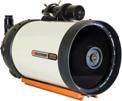 One potential disadvantage of this type of design is related to the addition of the corrector lens (arrow) in the baffle tube. This lens will limit the airflow in the rear mirror area and could extend the cool down time of the mirror and telescope interior. To deal with this, the design includes two rear vents (with 60 micron micro-mesh filter) to assist in cooling.
One potential disadvantage of this type of design is related to the addition of the corrector lens (arrow) in the baffle tube. This lens will limit the airflow in the rear mirror area and could extend the cool down time of the mirror and telescope interior. To deal with this, the design includes two rear vents (with 60 micron micro-mesh filter) to assist in cooling.
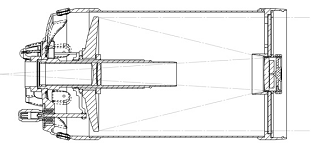
 A suggested approach to accelerate cooling, is to remove the secondary mirror (this can be done in 10 seconds with no tools and without impacting collimation) and remove the visual back to allow rapid air flow in both areas prior to imaging.
A suggested approach to accelerate cooling, is to remove the secondary mirror (this can be done in 10 seconds with no tools and without impacting collimation) and remove the visual back to allow rapid air flow in both areas prior to imaging.
The 11 inch EdgeHD looks just right in terms of aperture and DSLR astrophoto capability for my needs. As a final sell point, Celestron has finally added some 'mirror clutches' to help stabilize the primary mirror and reduce mirror shift. I made the purchase.
Testing 1,2,3 - As I write this article, I have had very little sky time with the EdgeHD and G-11 mount. My first light under dark skies, despite poor seeing, left me very pleased with its visual performance and the step gain in aperture. Since then my time has been spent on customization and learning the G-11 mount. I did get a 55mm Plossl eyepiece as a necessary accessory to regain the wider field views I enjoyed on the 8" SCT. I am also anxiously awaiting a promised focal reducer, designed specifically for the EdgeHD.
I did do some indoor testing to get a relative measure of 'how flat' is the EdgeHD. I hope to be doing some outdoor testing soon as the real proof will be seen in the stars. The testing was done by taking some 'flat' frames on the EdgeHD and on my Nexstar GPS. Flat frames may not fully represent a lack or presence of spherical aberration, as there are other sources of distortion to the light, but it was rainy outside and I needed to play.
To capture a flat frame, you simply need to photograph a featureless object of a single brightness. In this way the light entering the telescopes light path has the same intensity or brightness at every point of the optical path. A white tee shirt over the telescope in a bright room will suffice to produce a flat.
Below is a graph of a flat field photo from the Nexstar 8 GPS at its native f10 focal length. The line represents the brightness of the photo on a diagonal line, starting in the upper left of the image to the bottom right of the image. Ideally the light should be flat across the entire field, but for various reasons you can see the graph shows a curvature to the brightness across the center of the image, and for some reason (reflections, thermal noise?) there is a brightening distortion at each end.
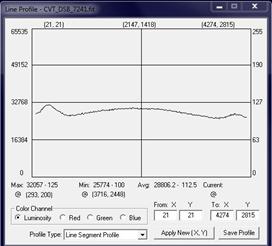 In comparison, the next graph shows the level of brightness across a flat image on the EdgeHD.
In comparison, the next graph shows the level of brightness across a flat image on the EdgeHD.
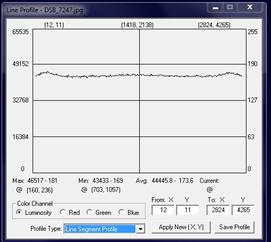 While it has the same characteristic hump at each end (but significantly smaller), it clearly shows just how evenly the light falls across the entire camera chip.
While it has the same characteristic hump at each end (but significantly smaller), it clearly shows just how evenly the light falls across the entire camera chip.
The final two graphs below compare the Nexstar 8 (left) with a focal reducer/corrector in place with the EdgeHD (right) with a non-native focal reducer (AP 0.67 focal reducer not designed for the EdgeHD) in place. The Nexstar 8 shows a very typical brightness curve, while on the EdgeHD, the light balance is still very flat.

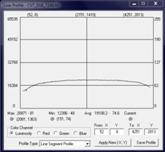
This was a quick and dirty test (and not completely apples to apples), but it does initially suggest one can expect a level of improved performance by the EdgeHD over the existing SCT technology.
Published in the September 2010 issue of the NightTimes




